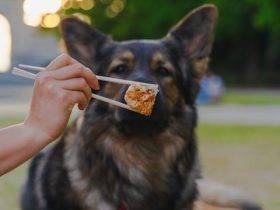Can Dogs Eat Beef Jerky
Beef jerky is a popular snack for humans, but many dog owners wonder – can dogs eat beef jerky too? In this comprehensive guide, we’ll explore the ins and outs of sharing beef jerky with your pooch, including potential risks and benefits. By the end, you’ll have all the information you need to make an informed decision about including occasional beef jerky treats in your dog’s diet.
Is Beef Jerky Safe for Dogs?
At first glance, beef jerky may seem like a safe and tasty treat for dogs since it’s made from beef. However, there are a few factors to consider regarding canines consuming beef jerky:
Sodium Content
Most commercial beef jerky is high in sodium due to the curing and drying process. Excessive sodium intake can lead to health issues for dogs like dehydration, upset stomach, and even salt poisoning in severe cases of overconsumption. Make sure to carefully monitor how much jerky your dog eats.
Spices and Seasonings
While the beef itself is generally okay for dogs, many jerky products contain added seasonings and spices that are unhealthy or even toxic to canines. Things like pepper, onion, and garlic powders can cause upset stomach or even an adverse reaction. Check the ingredients list carefully.
Fat Content
Fat provides flavor and moisture to beef jerky but can lead to pancreatitis if eaten in large quantities by dogs unaccustomed to high-fat foods. Start with small portions and see how your dog tolerates it before increasing.
Choking/Blockage Risk
The dried, tough texture of beef jerky poses a risk of choking or intestinal blockage, especially for small dogs or puppies. Always supervise jerky consumption and break sticks into small, bite-sized pieces.
While an occasional small piece of unseasoned beef jerky as a treat is generally okay for most dogs, it’s important to consider individual nutrition, size, and tolerance. Feeding jerky that’s low in sodium and contains no unhealthy additives in moderation poses the least risks.
The Best Types of Beef Jerky for Dogs
Not all beef jerky is created equal when it comes to canine consumption. Here are some safer options to look for:
Homemade Beef Jerky for dogs
Making your own jerky allows you to control ingredients for optimum dog-friendliness. Use lean ground beef or steak strips, limit salt, and avoid seasonings. Dehydrate strips at a low temperature.
Plain or Lower Sodium Jerky
Some brands offer plain or lightly seasoned beef jerky specifically formulated to be lower in sodium for canine diets. Check ingredients for absence of harmful additives.
Duck, Venison or Bison Jerky
Alternative meats like duck, venison or bison are used to make jerky as well. These are generally lower in fat than beef and may be better tolerated by dogs.
Small, Soft Pieces
Softer, pliable pieces of jerky that can be easily broken into small bites pose less choking risks than tough, thick strips. Supervise jerky consumption for young or small dogs.
With the right type and portion size, homemade or lower sodium beef jerky can occasionally be part of a balanced diet for dogs. Just proceed with caution, assess tolerance, and consult your vet with any concerns.
Health Benefits of Beef Jerky for dogs in Moderation
When fed judiciously as an occasional treat, beef jerky can provide some nutritional benefits for dogs:
Protein
High-quality protein from beef supports muscle growth, repair and overall health. This makes jerky a better choice than low-protein treats.
Zinc and Iron
Lean beef is a good source of zinc and iron, which aid the immune system and support red blood cell production.
Omega Fatty Acids
Grass-fed beef can provide heart-healthy omega-3 and omega-6 fatty acids to support skin and coat health when part of a balanced diet.
Dental Health
Crunching on jerky may help scrape plaque from teeth, reducing dental disease risk when chewed. However, hard jerky also risks fractures so supervise for safety.
Feeding jerky as 5% or less of total calories on rare occasions can allow dogs to enjoy the flavors and nutrition of real meat treats when choosing the right type and monitoring quantity. Consult your vet for individual recommendations.
How to Feed Beef Jerky for dogs Safely
When introducing any new food, including occasional beef jerky, it’s always best to start slowly and observe your dog for any signs of intolerance. Here are some guidelines:
Read Labels Carefully
Check ingredients of all jerky to avoid unsafe seasonings, added sugars, or excess sodium.
Start With Tiny Pieces
Give one or two very small, pea-sized pieces to begin and increase slowly over weeks if no issues arise.
Monitor Reaction Closely
Watch for digestive upset, diarrhea or other symptoms. Discontinue if any occur.
Limit Frequency
Reserve jerky as an occasional reward only, no more than 1-2 times per month.
Assess Your Dog’s Size
Very small or toy breeds may not tolerate jerky well due to choking risk.
Store Properly
Keep jerky refrigerated to maintain freshness and prevent mold growth.
Introducing new foods takes patience. By going slowly and observing your dog, you can safely include jerky as a special part of their diet once you know how they handle it. Always prioritize balanced nutrition tailored to your individual canine.
FAQs About Feeding Beef Jerky to Dogs
Here are some answers to frequently asked questions:
Can puppies eat beef jerky? Puppies are still developing and growing, so it’s best to avoid jerky until 6 months or older to reduce choking risk. Stick to puppy-appropriate chews and treats.
Does jerky clean dogs’ teeth? While crunchy jerky may help scrape plaque, it also risks fractures. Dental toys and treats or regular brushing are safer options. Supervise jerky chewing.
What if my dog steals jerky? Remain calm but do not reward begging. Instead, keep tempting human foods out of reach to prevent unhealthy habit-forming.
How much jerky is too much? More than 5-10% of total calories or feeding jerky daily can cause health issues. Treat it as an occasional reward only to avoid digestive upset.
Is the fat in jerky okay? Moderate amounts are generally fine for most dogs, but those prone to pancreatitis may require special low-fat diets. Watch individual tolerance.
With care and moderation, beef jerky can potentially be an occasional special part of a balanced diet for adult dogs. But it’s important to assess your own dog’s health, size, and habits to determine if and how much jerky may be suitable as a rare reward. Consult your vet with any medical concerns.
Homemade Beef Jerky Recipes For Dogs
While store-bought jerky has its risks, making your own allows complete control over ingredients. Here are two simple homemade beef jerky recipes perfect for dogs:
Basic Beef Jerky
Ingredients:
- 1 lb lean ground beef or steak strips
- 1 tsp Worcestershire sauce
- 1/4 tsp each garlic powder, salt (optional)
Instructions:
- Slice beef into 1/4-inch thick strips. Mix seasonings into ground meat or coat strips.
- Arrange strips on dehydrator racks, leaving space between.
- Dehydrate at 160°F for 6-8 hours until hard and dry. Store in fridge.
Duck Jerky
Ingredients:
- 1 lb duck breast, sliced
- 1/4 cup duck or chicken broth
- 1 tsp rosemary
Instructions:
- Combine broth and rosemary in a Ziploc bag. Add duck strips and marinate 1 hour.
- Arrange marinated strips on dehydrator racks. Dehydrate at 160°F for 6-8 hours
Here are some additional tips for homemade beef jerky for dogs:
Variations
- Try different lean meats like bison, venison or salmon for variety.
- Herbs like parsley or basil add nutrition without seasoning risks.
- For texture, try drying coconut strips or banana chips as healthy dog treats.
Preparation
- Use deli or freezer paper to line racks for easy removal once dried.
- Slice meat against the grain for shorter, softer strips safety.
- Marinating enhances flavor but isn’t required – meat alone is still nutritious.
Drying Process
- Monitor until leathery and dry all the way through but still pliable.
- Over-drying makes jerky too tough and increases choking risk.
- For safety, break into small pieces once cooled completely before serving.
Storage
- Keep homemade jerky refrigerated in an airtight container up to 1 week.
- Freeze extra in portions to maintain freshness for 1-2 months.
- Rotate stock so older batches are used first. Discard any showing mold.
Homemade allows careful preparation to reduce risks while maximizing nutrition from all-natural beef. It’s the best way to include occasional jerky in your dog’s diet when store-bought options may not be suitable. With the right techniques, you can feel good about your hand-crafted beef treats for dogs.






Leave a Reply